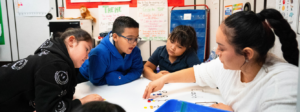American Federation of Teachers president Randi Weingarten made a trip to California last week to talk about the virtues of “collaboration” between teachers’ unions and superintendents. She advised education leaders to abandon their criticism about unions’ political tactics and instead embrace a strategy of “quietly, slowly and steadily turning foes into allies with one aim—partnering for student success.”
She also suggested that her fellow union leaders tone down their own rhetoric, asking, “Is a manager or a principal really going to be willing to help us solve a problem after we’ve punched the living daylights out of them?”
It’s a nice sentiment, but here’s the problem: Weingarten gave this speech even as her union is bankrolling nasty, deceptive attack ads that clearly attempt to “punch the living daylights” out of Marshall Tuck, a candidate in a neck-and-neck race for Superintendent of Public Instruction—in California, no less. I’d be interested to hear Weingarten explain how a website featuring a fake rich guy lighting a cigar with a $100 bill (really) and a tv ad featuring fake Wall Street tycoons stealing a kid’s sandwich would promote “collaboration” with Tuck if he becomes superintendent. (Tuck’s big transgression, by the way, is that he once worked at an investment bank, years before operating some of the most successful public schools in Los Angeles.)
In fact, Weingarten couldn’t even resist attacking her opponents in a speech about how everybody in education should stop attacking their opponents. After waxing poetic about the need for collaboration, she ripped into former Los Angeles Unified School District superintendent John Deasy for a lack of integrity, decrying him for following “the dictates of wealthy backers like Eli Broad” (the verbal equivalent of a cartoonish picture of a rich guy on a website, I guess). She suggests that he was forced to resign recently because of his “refusal to deeply work with those closest to the classroom.”
Now, this is the same John Deasy who’s a lifelong educator, who grew up in a strong union household, and who publicly expressed his support not just for teacher voice but for teachers’ unions on a regular basis. He’s the guy who once said, in what apparently didn’t live up to Weingarten’s standards for collaboration, “I have to lead hope in the work force… And if we can't treat each other everywhere in the district with dignity, we won't see the dignity in our students.” And while I’m not steeped in West Coast politics, it seems pretty clear that Deasy departed after a school board election in which a candidate backed by union contributions won and created a union majority that opposed his agenda.
So essentially, Weingarten is telling everyone in education that they should do as she says, not as she does. It seems pretty clear that the AFT’s real definition of collaboration goes something like this: Let’s all agree to embrace the AFT’s agenda, or else we will “collaborate” you right out of whatever office you hold by any political means necessary. As we’ve written before, the attempt to put a friendlier spin on this attitude is just a cynical political strategy on top of a strategy that’s already pretty cynical.
There’s nothing inherently wrong with any of this, of course. Like it or not, education policy will always be wrapped up in politics, and Weingarten is certainly free to be a win-at-all-costs political heavyweight if that’s what she wants. But until she starts walking the “collaboration” talk, Weingarten shouldn’t be surprised to find that few are interested in collaborating with her.








